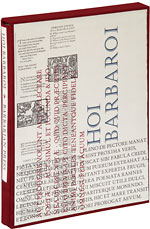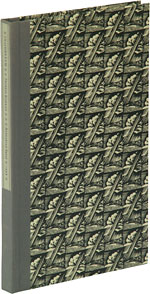Here Come the Barbarians
For craftspeople—the Elsteds categorically state that “private press printing is a craft, not an art”—so dedicated to the written word, an awful lot of their work has been directed to the visual, most notably to wood engravings. Four of their most arresting volumes are under the general title of Endgrain, which refers to the fact that the art in the books includes “only engravings (i.e., cut on end grain) & not wood cuts (cut on side or plank grain).” The first, published in 1995, is Endgrain: Contemporary Wood Engraving in North America, a compendium of more than 100 Canadian and American engravers. In 2000, they published Endgrain Editions One: Gerard Bender à Brandis, a selection of this Canadian artist’s work, a man best known for his botanical studies, but whose “Window,” included in the book, is about as powerful a wood engraving as I have ever seen. In 2001 Barbarian published Endgrain Editions Two: Abigail Rorer, which, coincidentally, brings us to the work of an artist we wrote about in the most recent issue of FB&C. (“I can honestly say that I wouldn't be where I am now with my engraving without their encouragement and support,” Rorer said.) In 2003, Barbarian published Endgrain Editions Three: Peter Lazarov, a Bulgarian artist who has been living and working in the Netherlands for the last 20 years.
My favorite book of Barbarian’s of all the ones I examined—and I haven’t been able to examine all of them because of the Canadian logistics and customs difficulties—is Inishbream by Theresa Kishkan, published in 1999. “That’s a lot of people’s favorite book,” Crispin said. “For one thing, it’s a very good read.” But that’s not the main reason I like the book. Inishbream, which is about a woman’s visit to rural Ireland, more than any other book by Barbarian that I looked at, seems to me to embody that philosophy the Elsted’s stated so eloquently: “We feel that nothing should come between the text and the reader.” I can round up the usual suspects and tell you that it was hand set in 12-point Joanna and printed on Zerkall Silurian mouldmade paper, etc., but that, to my mind, is like attributing the excellence of a Velasquez to the quality of the paint. What a reader senses in reading Inishbream is a fine, subtle guiding hand, a hand with a deep comprehension of not just type and printing, but of reading and words and storytelling.
Barbarian’s next book will be Shakespeare’s The Play of Pericles, which Crispin and Jan have been working on for five years. Talking to Crispin Elsted about this project, one can sense that bated urgency that comes from pride and passion. This is a book that is important to him. “We anticipate Pericles being our most beautiful book to date,” he said. “It will include extensive notes and a major essay on the play in a separate volume.” Crispin’s involvement is not just typographic. He has re-edited the text, drawing on a novel popular at the time and from which Shakespeare drew for the story. The book will be illustrated with wood engravings by Simon Brett. All the deluxe copies have already been reserved, and half of the 100 standard copies they intend to print are reserved for patrons and subscribers, as well. “Our intention,” Crispin said, “is to publish a text which will be a pleasure to read, and which will allow the glories of this unfairly neglected play to find new devotees.”
COLOPHON
Amours de Voyage, an Epistolary Novella in Verse
 By Arthur Hugh Clough (2007). Van Dijck roman and italic with calligraphic display by Martin Jackson, printed in burgundy and black on Zerkall Book Soft White Wove. Illustrated with 11 relief engravings by Abigail Rorer, printed from the blocks. Bound by Rasmussen Bindery in quarter burgundy silk with St-Armand handmade paper printed in burgundy, deep yellow and black, with a design by Crispin Elsted. 88 pages. 125 copies. C $390.; US $390. Winner of the Judges’ Award, Oxford Fine Press Book Fair, 2007.
By Arthur Hugh Clough (2007). Van Dijck roman and italic with calligraphic display by Martin Jackson, printed in burgundy and black on Zerkall Book Soft White Wove. Illustrated with 11 relief engravings by Abigail Rorer, printed from the blocks. Bound by Rasmussen Bindery in quarter burgundy silk with St-Armand handmade paper printed in burgundy, deep yellow and black, with a design by Crispin Elsted. 88 pages. 125 copies. C $390.; US $390. Winner of the Judges’ Award, Oxford Fine Press Book Fair, 2007.
Hoi Barbaroi: A Quarter Century at Barbarian Press, A Bibliography with Essays by Invitation, and a Photographic Essay by David Evans (2004).
 Winner, Judge’s Award, Oxford, 2005.
Winner, Judge’s Award, Oxford, 2005.
Deluxe edition: Hand set in Bembo and Fairbanks italic with Bembo and Castella for display. Facsimile text of earlier edition printed in offset facsimile from the original pages. Numerous tip-ins and illustrations, from wood engravings to pages from the original press runs of books. David Evans’ photographic essay laid out at the press and printed in tritone by Western Printers with captions digitally set. Printed in two colors on Zerkall mouldmade papers. Hand bound by Simone Mynen in quarter leather with printed paper over boards, gold stamped leather label on spine. Accompanied by a clamshell box containing numerous original examples of ephemera going back to the beginnings of the press, and an additional signed studio print by David Evans. Book and box contained in a slipcase. 156 pages; 60 copies O/P.
Crispin & Jan Elsted, Proprietors
12375 Ainsworth Road, R.R. 8
Mission, British Columbia V4S 1L4, Canada
Tel: (604) 826 8089
Regular edition: Quarter bound by Rasmussen Bindery in cloth and printed paper over boards, printed label on spine. Same inclusions as deluxe edition within book. Slipcased. 156 pages. 150 copies. C $650.; US $570. plus postage. Winner of the Judge’s Award, Oxford Fine Press Book Fair, 2005.











 Richard Goodman is the author of
Richard Goodman is the author of